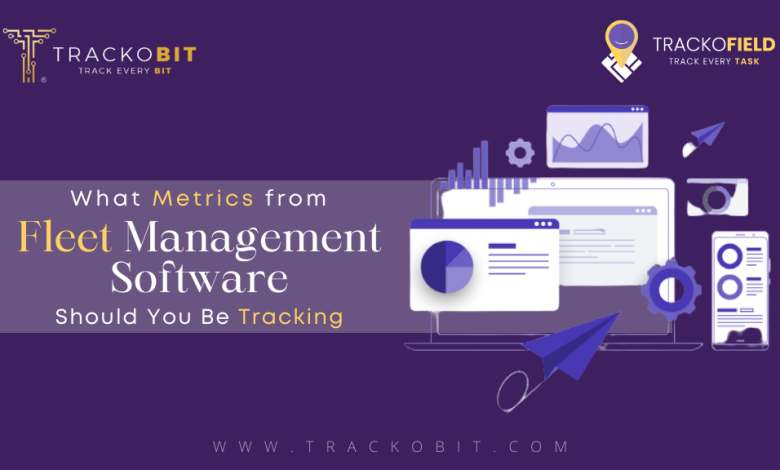What Metrics from Fleet Management Software Should You Be Tracking?

Using Fleet Management Software for simply tracking vehicles is one thing. However, what sets a good fleet manager apart from an inefficient one is how they use fleet metrics. Anyone can track vehicles and collect data. However, what data one chooses to use and how they use it makes a huge difference in defining how the fleet will perform.
Do you use a potent GPS Tracking Software that can collect geospatial and OBD data and present it in bite-sized reports? Good! Now, let’s learn what metrics you should be following to get the most out of your fleet in the long run.
What Fleet Management Metrics Can Fleet Managers Not Ignore?
Sure, your vehicle tracking software has a lot of metrics to collect and offer in reports. Yes, using all of them in the budgeting and strategizing process will make a huge difference in productivity. However, as a manager, do you have time to look into every shred of data the software shows you? We’re sure not! Therefore, let us discuss the different metrics you cannot ignore!
1. Maintenance and Repair Reports
Maintenance reports such as vehicle inspection reports before and after trips and Daily Vehicle Inspection Reports (DVIR) are very important to note. You can leverage that data to keep a check on how well your vehicles are performing and understanding your assets’ health.
DVIR reports help you keep track of common inspection failures. Keeping them in mind and solving those issues is perfect for reducing downtime in your fleet.
You should also take note of preventive maintenance practices you get through these maintenance reports. The right fleet management software system will give you both a granular and eagle-eye view of all your assets in real-time.
2. Odometer Reports
Odometer readings can be paired with several other fleet metrics to know how a vehicle is performing in your fleet. When paired with Fuel Management Systems, you can see which vehicles are consuming the most amount of fuel in the least traveled distance. Having this knowledge is spectacular while altering your fleet size and components.
Installing telematics devices in your vehicles will help you get automatic updates on the required data in your fleet. With this data, you are essentially increasing the visibility of your fleet.
3. Cost of Ownership
Knowing the total cost of ownership of your fleet can be extremely tricky. However, it is one of the most important metrics you need to keep in mind. Why? Because this is how you will know how much your investment into the fleet is and how much you need to make to get to your profit goals.
While knowing your fleet’s Total Cost of Ownership (TCO) is tricky, it can be made significantly simpler with a potent fleet management software system. Only with this information can you understand the Return on Investment (ROI) that your fleet is offering you in the long run.
In case your ROI is not at par according to your TCO, you can make amends to increase your profitability. If your assets are not optimal, you could lease them out. On the other hand, if you need assets but cannot increase your fleet’s TCO, you could just lease vehicles instead of buying them.
4. Asset Utilisation
Investing in vehicles and everything they need to run on does not come cheap. Therefore, you need to do the most that you can with all your assets. Knowing how your assets are functioning and where they function in increasing your ROI will help improve profitability as well as asset lifespan.
You should track the average distance each vehicle runs each day. This will not only help you get a sense of asset utilization in your fleet but also in scheduling.
Only when you have successfully monitored your fleet for a couple of months can you clearly see under-utilized and over-utilized vehicles. If you see a disparity in how your vehicles are functioning, it might be time to change schedules and shifts for each vehicle. Moreover, you can also use this information to either increase operations or discard some assets.
Utilizing your assets to their maximum comfortable capacity will help you get to that sweet spot in terms of profitability. It will also help you avoid costly unforeseen expenses, and will also help reduce downtime in your fleet.
5. Safety Metrics
Tracking safety metrics to increase ROI sounds silly, right? After all, how will safety directly influence the amount of money your fleet is making!
Well, that is the point. Safety doesn’t directly influence, making several people forget about its importance. However, the impact that it does make is extremely relevant.
If your vehicles are constantly under threat of theft, you might want to change their route to prevent such things from happening in the future. Moreover, you can also check which areas are the worst in terms of emergencies, warning all of them.
In case your vehicle is under the threat of theft, your driver being able to push an SOS button for help might just save your fleet.
6. Driver Assessments
Driver Behavior Monitoring is extremely important. After all, a driver is to a car what a CEO can be to any organization. If the manager is not effective, the entire team will crumble.
You should pay close attention to reports such as harsh cornering, harsh acceleration, and braking. By singling out bad drivers and vehicles, you can take the required actions to get the most out of your fleet.
Driver assessment also helps you get an idea of what drivers should be driving which vehicles. For example, you can assign your best and most economical driver a not-so-perfect vehicle to balance out both assets’ strengths and weaknesses.
Summing Up
Here you have it! A list of some of the most important metrics you should always keep in mind while strategizing your fleet budget.
Use your Vehicle Tracking Software system not only for knowing where your vehicles are but also for analyzing their performance. That is the only way you’re going to get the most results out of your fleet management software system and increase your business baseline. So, what are you waiting for? Read this blog to learn how to choose the best fleet management software system for your fleet and make the right managerial decision today!





